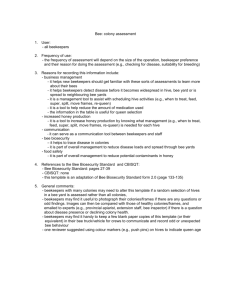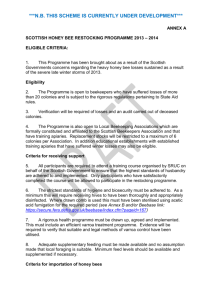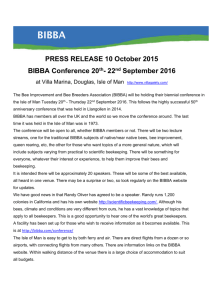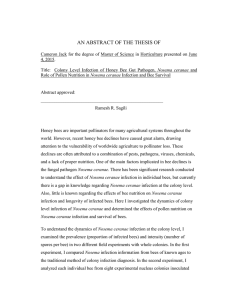Reference: Disease Liaison Officers Report
advertisement
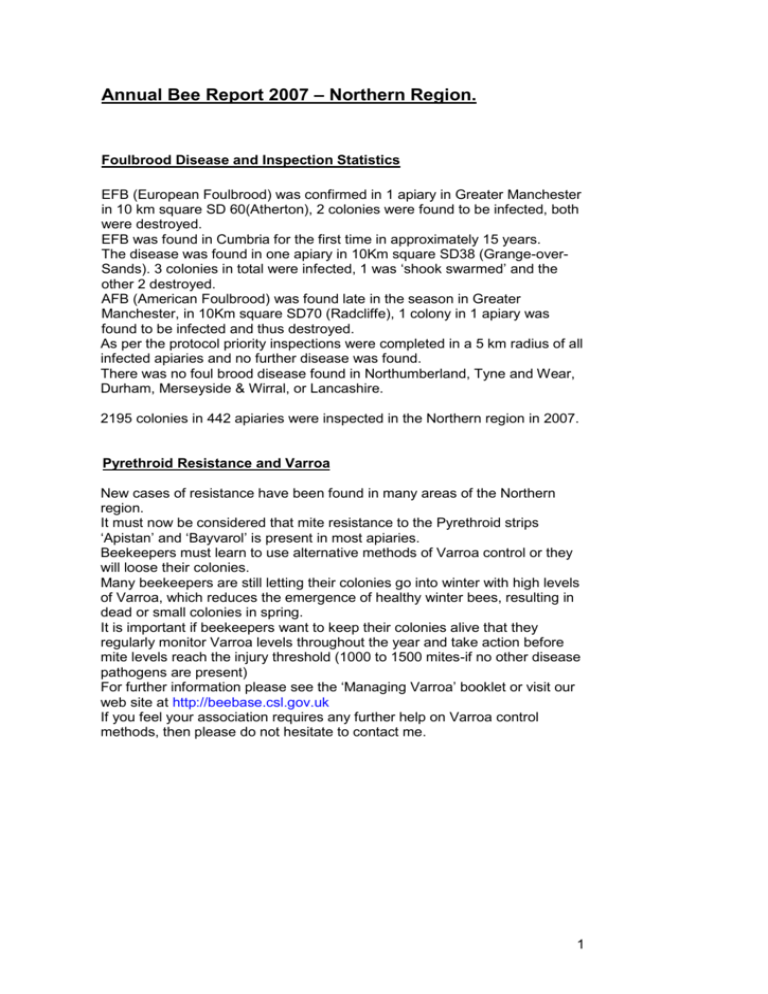
Annual Bee Report 2007 – Northern Region. Foulbrood Disease and Inspection Statistics EFB (European Foulbrood) was confirmed in 1 apiary in Greater Manchester in 10 km square SD 60(Atherton), 2 colonies were found to be infected, both were destroyed. EFB was found in Cumbria for the first time in approximately 15 years. The disease was found in one apiary in 10Km square SD38 (Grange-overSands). 3 colonies in total were infected, 1 was ‘shook swarmed’ and the other 2 destroyed. AFB (American Foulbrood) was found late in the season in Greater Manchester, in 10Km square SD70 (Radcliffe), 1 colony in 1 apiary was found to be infected and thus destroyed. As per the protocol priority inspections were completed in a 5 km radius of all infected apiaries and no further disease was found. There was no foul brood disease found in Northumberland, Tyne and Wear, Durham, Merseyside & Wirral, or Lancashire. 2195 colonies in 442 apiaries were inspected in the Northern region in 2007. Pyrethroid Resistance and Varroa New cases of resistance have been found in many areas of the Northern region. It must now be considered that mite resistance to the Pyrethroid strips ‘Apistan’ and ‘Bayvarol’ is present in most apiaries. Beekeepers must learn to use alternative methods of Varroa control or they will loose their colonies. Many beekeepers are still letting their colonies go into winter with high levels of Varroa, which reduces the emergence of healthy winter bees, resulting in dead or small colonies in spring. It is important if beekeepers want to keep their colonies alive that they regularly monitor Varroa levels throughout the year and take action before mite levels reach the injury threshold (1000 to 1500 mites-if no other disease pathogens are present) For further information please see the ‘Managing Varroa’ booklet or visit our web site at http://beebase.csl.gov.uk If you feel your association requires any further help on Varroa control methods, then please do not hesitate to contact me. 1 Colony Losses. At the moment the laboratory staff at the NBU (National bee Unit) are working on abnormal colony losses in some commercial beekeepers apiaries outside the Northern region. It has been found that there is a higher incidence than normal of CPV (Chronic Paralysis Virus) and some Nosema in the dead colonies. CPV is not thought to be linked directly to Varroa, but is thought to be spread through confinement and stress. The adult bees in live colonies affected by CPV, sometimes show signs of a ‘shivering’ effect on top of the frames and combs, live bees outside the hive tend to be black and shiny (hairless) and can be seen crawling up grass stems and around the front of the hive, they then die quickly, particularly if other disease pathogens are present. Often large amounts of dead bees are found outside the hive. Interestingly, some of the dead colonies show no sign of disease; we must therefore presume a nutritional problem. Once tests are completed the results will be published on the bee unit web site at http://beebase.csl.gov.uk. If you or any of your members discover any unusual colony losses or bees displaying any of the above symptoms, please get in touch with me. It is important that any adult bees and frames are not disposed of, as we may need these for analysis. As normal, it is worthwhile to block off the entrances of any dead colonies to avoid robbing. Please find below a graph showing colony losses in England and Wales since 1998. Dead Colonies Observed During Inspections in England and Wales 3500 3000 2500 2000 Dead Colonies 1500 1000 500 0 1998 2000 2002 2004 2006 2008 2 Nosema ceranae Nosema ceranae has recently been confirmed in England & Wales and has been linked with colony losses in Europe. Because it is difficult to distinguish between Nosema apis and Nosema ceranae using microscopical examination, it is possible that Nosema ceranae has been present in this country for some time. Should you or your members suspect Nosema disease, it is important to undertake microspical examination of the bee’s gut (approx. 30 bees required) to confirm the disease is present. Once confirmed, treatment is the same as for Nosema apis, by using ‘Fumidil B’ in sugar syrup. Any small or weak colonies should be destroyed. Sterilization of bee less combs and boxes can be completed by fumigation using Acetic acid. Any poor or soiled combs should be burnt. Wooden hive parts should also be scorched with a blowtorch. It is also important to get colonies onto new comb as soon as possible by using the ‘Bailey’ frame change’ or ‘shook swarm’ method of comb replacement. Please take care when using Acetic acid, as it is corrosive (it affects steel runners, steel ends and exposed steel frame wires) and can burn skin etc. If you would like any information on Nosema diagnosis, Acetic acid instructions or the ‘Bailey frame change’ or ‘shook swarm’ methods of comb replacement, then please do not hesitate to contact me. The NBU will be producing a advisory leaflet in the near future. Please find below a report from Mike Brown Head of the Bee Unit: Confirmation of Nosema ceranae in England and Wales. Three hundred and nine samples have now been tested for the presence of Nosema apis and Nosema ceranae using real-time PCR. All positive results were confirmed using published assays for the detection of these pathogens using real-time PCR with SYBR green chemistry (Cox-Foster et al., 2007). Positive results have therefore been confirmed using 2 methods both based on the detection of species specific DNA. Of these samples, 45 tested positive for Nosema species (14%) with 31 samples testing positive for N. apis (10%), 14 for N. ceranae (4.5%) and 3 (1%) testing positive for both Nosema species. N. ceranae positives were confirmed across seven counties of England (Cornwall Essex, Lincolnshire, Hertfordshire, Hereford and Worcestershire, Greater London, North Yorkshire) and three in Wales (Glamorgan, Pows, Dyfed). N. ceranae infections have been reported not to show typical signs of Nosema infection. Therefore we recommend beekeepers check their colonies for adult bee diseases. Treatment using the usual veterinary medicine treatment is effective against Nosema infections in honeybee colonies. It is also important to treat effectively against Varroa mite infestations We will carry out a more detailed survey to estimate the prevalence and impact of both Nosema species across England and Wales. Samples of DNA extracts from the European foul brood study, imported bees and historical samples stored in the NBU labs will be re-screened. References Foster et al., 2007. A Metagenomic Survey of Microbes in Honey Bee Colony Collapse Disorder. Science DOI: 10.1126/science.1146498 3 Small Hive Beetle At present there have been no reported cases of the SHB in the U.K. Each region’s bee officers have undergone a Contingency Planning Exercise to simulate the arrival of the beetle. Further SHB exercises will be taking place, when I shall be asking for volunteers from associations to attend. The 2007 season. Spring started well, with many beekeepers taking a spring crop. Some beekeepers that removed their entire spring crop ended up having to feed their bees and I and my seasonal inspectors often found colonies dying or dead due to starvation. Due to the good spring many colonies had made swarm preparations, but could not get out due to the un-seasonal weather in June, July and part of August, in fact it seemed to rain here for 10 weeks. Therefore many colonies ended up with virgin queens in and swarms decided to come out on any fine day. Some of the queens did not get mated and many beekeepers have had to unite their stocks. The Himalayan Water Balsam, Heather and Ivy crops seemed to save the day for the majority of beekeepers, with most beekeepers reporting excellent late crops. In general, honey crops in the Northern region were down approximately 40% on 2006. Seasonal Bee Inspector Contacts Merseyside/Wirral and Lancashire Doug Jones, (available April to end of August) ‘Honeysuckle’ 3 Seabank Road Lower Heswall Wirral, Cheshire. CH60 4SN Tel: 0151 342 7062 Cumbria Stewart Beattie (available April until end of July) ‘Helensdale House’ Long lane Stainton with Adgarley Barrow-in-Furness Cumbria. LA3 0NH. Tel: 01229463127 Continued…. 4 Durham, Northumberland and Tyne and Wear John Newton (available April to end of August) 150 Devonshire Road Durham County Durham DH1 2BL. Tel: 0191 386 3044 Details of disease incidence, research and news updates are regularly placed on the NBU website on www.nationalbeeunit.com or you can access our web based site at http://beebase.csl.gov.uk Electronic copies of this report are available from me or from the web based site. (New beekeepers can also register here) If there are any items in this report you would like to discuss, then please feel free to contact me. Just to remind you, I am available for lectures and demonstrations throughout the year, all cost being taken care of by the NBU. Finally, can I wish you a Happy New Year. Ian Molyneux. 10 Bramhall Ave, Harwood, Bolton. BL2 4EL Tel: 01204 381186 or 07815 872 604 (m). e-mail: i.molyneux@csl.gov.uk Northern Regional Bee Inspector 5
